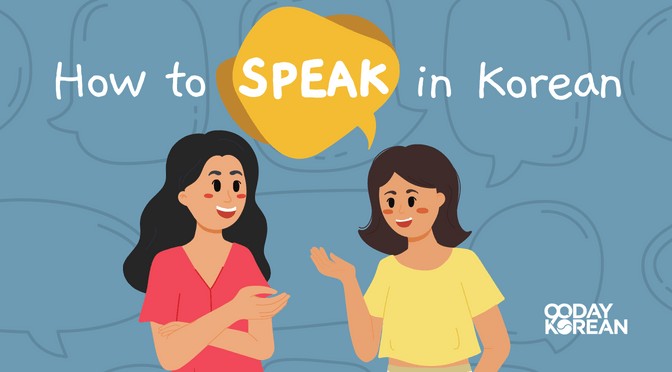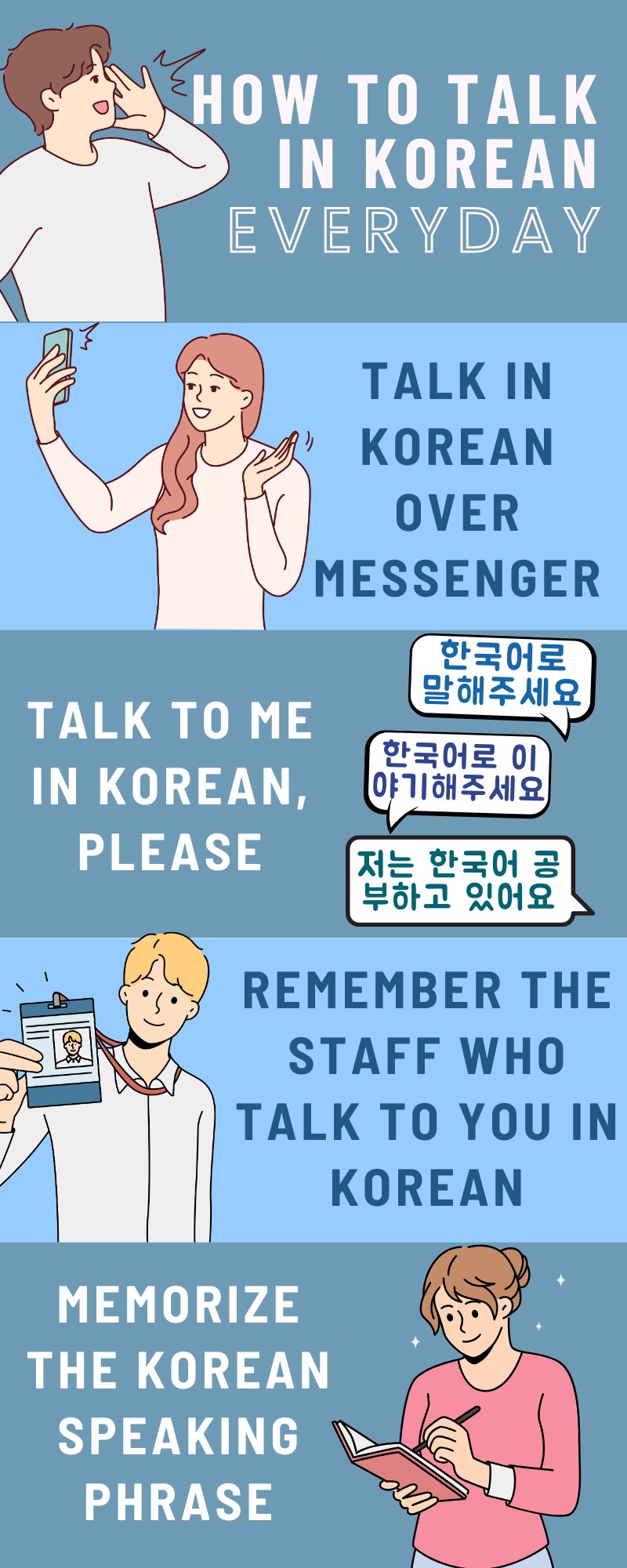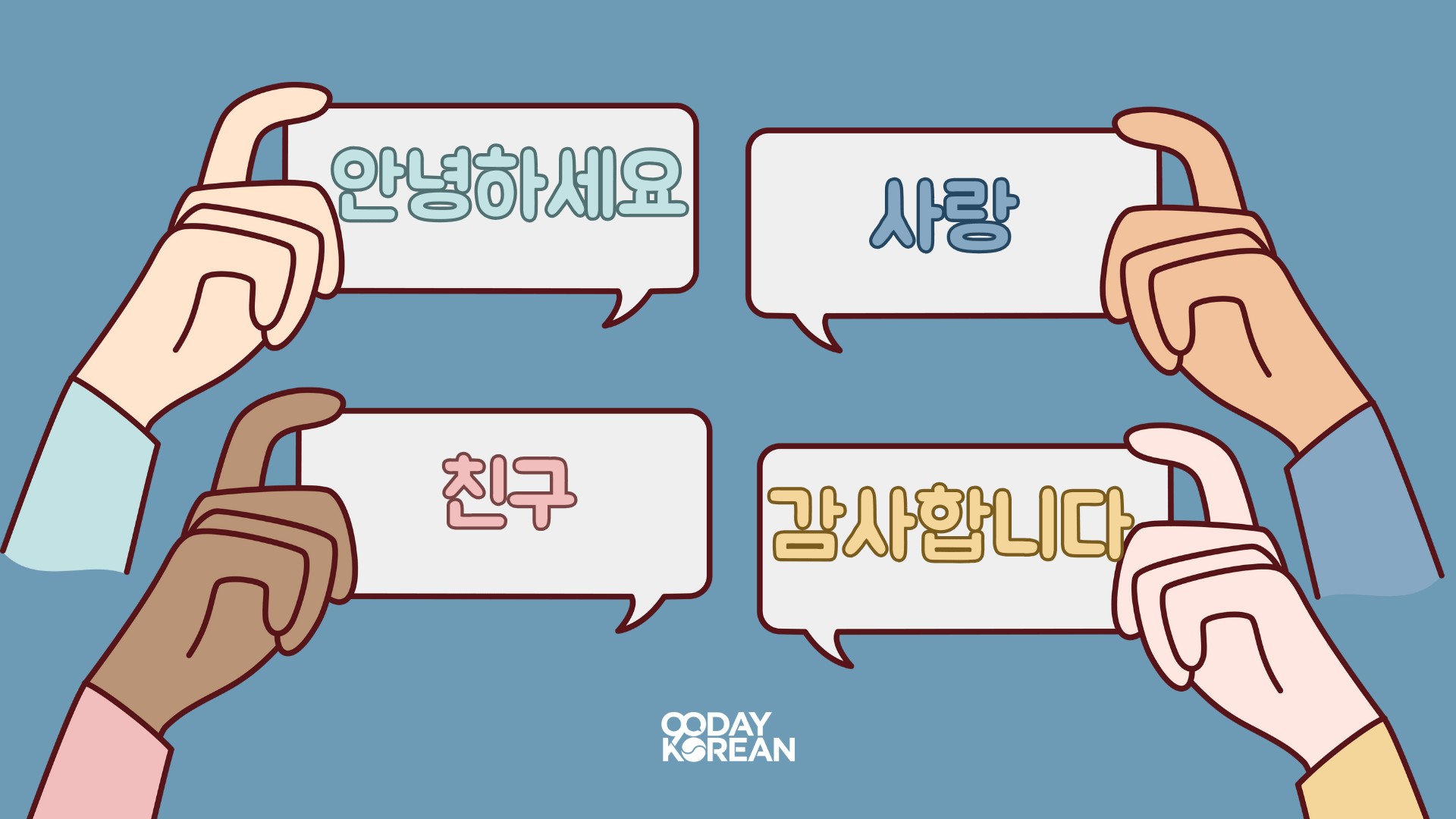Learning how to speak Korean can open doors to new cultures, friendships, and opportunities. At LEARNS.EDU.VN, we provide a comprehensive approach to mastering conversational Korean, focusing on practical skills and effective learning strategies. This guide will help you learn to speak Korean quickly and efficiently, emphasizing everyday phrases, essential vocabulary, and proven techniques.
1. Understanding Your Motivation to Speak Korean
Why do you want to learn to speak Korean? Identifying your motivation is the first step. According to a study by the University of Southern California, students who have a clear purpose are more likely to succeed in language learning. Some common reasons include:
- Cultural Interest: Enjoying K-dramas, K-pop, and Korean movies.
- Travel: Planning a trip to South Korea and wanting to communicate with locals.
- Relationships: Connecting with Korean friends, family, or significant others.
- Career: Seeking job opportunities that require Korean language skills.
Knowing your motivation will keep you focused and driven throughout your language learning journey. Whether it’s watching Korean dramas, communicating with friends, or career advancement, having a clear goal will enhance your learning experience. LEARNS.EDU.VN offers courses tailored to various motivations, ensuring you learn what matters most to you.
2. Setting Realistic Goals for Korean Language Acquisition
Setting achievable goals is crucial for staying motivated. Start with small, manageable targets. For example, aim to learn five new words a day or practice speaking for 15 minutes daily. According to research from Cambridge University, breaking down large tasks into smaller steps increases success rates. Here’s a sample plan:
- Week 1: Learn the Korean alphabet (Hangeul).
- Week 2: Master basic greetings and introductions.
- Month 1: Be able to have a simple conversation about yourself.
- Month 3: Understand basic Korean grammar and sentence structure.
- Month 6: Hold a more extended conversation on familiar topics.
Regularly review your progress and adjust your goals as needed. Celebrate your achievements, no matter how small, to maintain a positive attitude. LEARNS.EDU.VN provides tools and resources to track your progress and stay on target.
3. Mastering Hangeul: The Korean Alphabet
The Korean alphabet, known as Hangeul, is remarkably logical and easy to learn. It consists of 14 consonants and 10 vowels. Unlike many other languages, Hangeul was designed to be simple and accessible. According to the Korean Language Association, most people can learn Hangeul in just a few hours.
Tips for learning Hangeul:
- Use Online Resources: Many websites and apps offer interactive lessons and quizzes.
- Practice Writing: Write each letter repeatedly to memorize its shape and sound.
- Use Flashcards: Create flashcards with the letter on one side and its pronunciation on the other.
- Associate Letters with Sounds: Connect each letter to a familiar sound to aid memorization.
LEARNS.EDU.VN provides interactive Hangeul lessons that make learning fun and effective. Our resources include pronunciation guides, writing exercises, and quizzes to ensure you master the alphabet quickly.
4. Learning Basic Korean Vocabulary and Phrases
Building a solid vocabulary base is essential for speaking Korean. Start with the most common words and phrases used in daily conversations. Research from Seoul National University shows that learning the top 1,000 most frequent words can enable you to understand around 80% of everyday conversations.
Essential Korean Phrases:
| Phrase | Korean | Pronunciation |
|---|---|---|
| Hello | 안녕하세요 | Annyeonghaseyo |
| Thank you | 감사합니다 | Gamsahamnida |
| You’re welcome | 천만에요 | Cheonmaneyo |
| Excuse me | 실례합니다 | Sillyehamnida |
| I’m sorry | 죄송합니다 | Joesonghamnida |
| Yes | 네 | Ne |
| No | 아니요 | Aniyo |
| I don’t understand | 이해하지 못합니다 | Ihae haji mothamnida |
| Please speak slowly | 천천히 말씀해 주세요 | Cheoncheonhi malsseumhae juseyo |
| How much is it? | 얼마예요? | Eolmayeyo? |




LEARNS.EDU.VN offers extensive vocabulary lists and phrasebooks to help you build a strong foundation. Our resources include audio recordings to ensure you learn the correct pronunciation.
5. Understanding Korean Grammar Basics
Korean grammar differs significantly from English grammar. One of the key differences is the sentence structure, which typically follows a Subject-Object-Verb (SOV) order. According to a linguistic study by Yonsei University, understanding this structure is crucial for forming coherent sentences.
Key Grammar Points:
- Sentence Structure: SOV (Subject-Object-Verb). For example, “I apple eat” (나는 사과를 먹는다).
- Particles: These mark the grammatical function of nouns (e.g., subject, object, topic).
- Verb Conjugation: Verbs change based on tense, politeness level, and mood.
- Honorifics: Using appropriate language to show respect based on social status and age.
LEARNS.EDU.VN provides clear and concise grammar lessons with plenty of examples and exercises. Our interactive grammar tools help you practice sentence construction and verb conjugation.
6. Immersing Yourself in the Korean Language
Immersion is one of the most effective ways to learn a language. Surrounding yourself with Korean helps you internalize the language and improve your fluency. A study by the Middlebury Institute of International Studies found that immersion programs significantly boost language proficiency.
Ways to Immerse Yourself:
- Watch Korean Dramas and Movies: Start with subtitles and gradually reduce reliance on them.
- Listen to Korean Music and Podcasts: Pay attention to the lyrics and try to understand the meaning.
- Read Korean Books and Webtoons: Begin with simple texts and gradually increase the difficulty.
- Change Your Device Language: Set your phone, computer, and social media to Korean.
LEARNS.EDU.VN recommends incorporating Korean entertainment into your daily routine. Watch K-dramas, listen to K-pop, and read Korean literature to enhance your learning experience.
7. Practicing Speaking Korean with Native Speakers
Speaking practice is essential for developing fluency. Find opportunities to speak with native Korean speakers to improve your pronunciation, grammar, and vocabulary. Research from Harvard University indicates that regular interaction with native speakers significantly improves language acquisition.
Ways to Practice Speaking:
- Language Exchange Partners: Use online platforms to find native Korean speakers who want to learn your language.
- Korean Tutors: Hire a tutor for personalized lessons and feedback.
- Language Meetups: Attend local Korean language meetups or conversation groups.
- Travel to Korea: Immerse yourself in the language and culture by traveling to South Korea.
LEARNS.EDU.VN connects you with native Korean speakers for language exchange and tutoring. Our platform provides a supportive environment to practice speaking and receive constructive feedback. Address: 123 Education Way, Learnville, CA 90210, United States. Whatsapp: +1 555-555-1212. Trang web: LEARNS.EDU.VN.
8. Utilizing Language Learning Apps and Resources for Korean
Numerous language learning apps and resources can supplement your Korean studies. These tools provide interactive lessons, vocabulary drills, and pronunciation practice. A study by Georgetown University found that using language learning apps can significantly improve language proficiency.
Recommended Apps and Resources:
- Duolingo: Offers gamified lessons for vocabulary and grammar.
- Memrise: Uses spaced repetition to help you memorize words and phrases.
- HelloTalk: Connects you with native speakers for language exchange.
- Anki: A flashcard app that uses spaced repetition to enhance memory.
LEARNS.EDU.VN integrates with popular language learning apps to provide a seamless learning experience. Our platform offers curated lists of resources to help you find the tools that best suit your learning style.
9. Focusing on Korean Pronunciation
Accurate pronunciation is crucial for effective communication. Pay attention to the nuances of Korean pronunciation, including vowel sounds, consonant clusters, and intonation. According to a study by the University of Texas at Austin, focusing on pronunciation early on can prevent the development of bad habits.
Tips for Improving Pronunciation:
- Listen to Native Speakers: Pay attention to how native speakers pronounce words and phrases.
- Record Yourself: Record yourself speaking Korean and compare it to native speakers.
- Use Pronunciation Guides: Many online resources provide detailed pronunciation guides.
- Practice Minimal Pairs: Practice distinguishing between similar-sounding words.
LEARNS.EDU.VN offers pronunciation guides and audio recordings to help you master Korean sounds. Our platform includes interactive exercises to practice pronunciation and receive feedback.
10. Understanding Korean Culture and Context
Language is deeply intertwined with culture. Understanding Korean culture and context is essential for effective communication. According to a study by UCLA, cultural knowledge enhances language comprehension and fluency.
Key Cultural Aspects:
- Hierarchy: Respect for elders and those in higher social positions is crucial.
- Collectivism: Emphasis on group harmony and cooperation.
- Politeness: Using appropriate language to show respect and consideration.
- Nonverbal Communication: Understanding gestures, facial expressions, and body language.
LEARNS.EDU.VN incorporates cultural insights into our lessons to provide a comprehensive understanding of the Korean language. Our resources include articles, videos, and cultural notes to enhance your learning experience.
11. Creating a Study Schedule and Sticking to It
Consistency is key to language learning. Create a study schedule and stick to it as much as possible. According to research from Stanford University, consistent study habits lead to better retention and faster progress.
Tips for Creating a Study Schedule:
- Set Realistic Goals: Plan to study for a manageable amount of time each day.
- Choose a Consistent Time: Study at the same time each day to establish a routine.
- Find a Quiet Place: Study in a distraction-free environment.
- Use a Planner: Track your progress and stay organized.
LEARNS.EDU.VN provides tools to help you create and manage your study schedule. Our platform sends reminders and progress reports to keep you motivated and on track.
12. Using Mnemonics and Memory Techniques for Korean
Mnemonics and memory techniques can help you memorize new words and phrases more effectively. According to a study by the University of California, Irvine, using mnemonics can significantly improve memory retention.
Effective Memory Techniques:
- Association: Link new words to familiar concepts or images.
- Acronyms: Create acronyms using the first letters of a phrase.
- Rhymes: Use rhymes to make words and phrases more memorable.
- Visualization: Create mental images to associate with new words.
LEARNS.EDU.VN incorporates mnemonics and memory techniques into our lessons to help you memorize vocabulary more effectively. Our platform provides visual aids and memory prompts to enhance your learning experience.
13. Learning Korean Slang and Idioms
Learning slang and idioms can make your Korean sound more natural and fluent. These expressions are commonly used in everyday conversations and can add color to your speech. According to a study by the University of Pennsylvania, familiarity with slang and idioms enhances communication skills.
Common Korean Slang and Idioms:
- 꿀잼 (kkuljaem): Something that is very fun or enjoyable.
- 멘붕 (menbung): A mental breakdown or feeling overwhelmed.
- 핵인싸 (haeginssa): Someone who is very popular and outgoing.
- 밥 먹었어? (bap meogeosseo?): Have you eaten? (a common greeting).
LEARNS.EDU.VN provides lessons on Korean slang and idioms to help you sound more natural and fluent. Our resources include explanations and examples of how to use these expressions in context.
14. Setting Up a Korean Learning Environment
Creating a dedicated Korean learning environment can help you stay focused and motivated. This environment should be free from distractions and equipped with all the necessary resources. According to a study by the University of Michigan, a well-organized learning environment enhances productivity.
Elements of a Korean Learning Environment:
- Quiet Space: Choose a quiet room or corner where you can study without interruptions.
- Learning Materials: Keep your textbooks, notebooks, and flashcards within easy reach.
- Visual Aids: Decorate your space with Korean posters, calendars, and maps.
- Technology: Ensure you have a reliable internet connection and access to language learning apps.
LEARNS.EDU.VN offers tips and resources to help you set up an effective Korean learning environment. Our platform provides digital tools and visual aids to enhance your study space.
15. Staying Motivated and Overcoming Challenges in Korean Learning
Language learning can be challenging, and it’s important to stay motivated and overcome obstacles. According to research from Yale University, maintaining a positive attitude is crucial for language learning success.
Tips for Staying Motivated:
- Set Achievable Goals: Break down large tasks into smaller, manageable steps.
- Reward Yourself: Celebrate your achievements with small rewards.
- Find a Study Buddy: Learning with a friend can provide support and motivation.
- Join a Community: Connect with other Korean learners for encouragement and advice.
LEARNS.EDU.VN provides a supportive community where you can connect with other learners and share your experiences. Our platform offers motivational tips and resources to help you stay on track.
16. Utilizing Korean Media for Language Practice
Korean media offers a wealth of opportunities for language practice. Watching Korean dramas, listening to K-pop, and reading Korean books can improve your listening comprehension, vocabulary, and cultural understanding. According to a study by the University of Southern California, using media for language practice enhances learning outcomes.
Effective Ways to Use Korean Media:
- Watch Dramas with Subtitles: Start with subtitles in your native language and gradually switch to Korean subtitles.
- Listen to Music and Follow Lyrics: Pay attention to the lyrics and try to understand the meaning.
- Read Books and Webtoons: Begin with simple texts and gradually increase the difficulty.
- Follow Korean Social Media: Follow Korean influencers and celebrities on social media.
LEARNS.EDU.VN recommends incorporating Korean media into your daily routine. Watch K-dramas, listen to K-pop, and read Korean literature to enhance your learning experience.
17. Conversational Practice: Role-Playing in Korean
Role-playing is an effective way to practice speaking Korean in realistic scenarios. By simulating real-life conversations, you can improve your fluency, vocabulary, and confidence. According to a study by the University of Cambridge, role-playing enhances communicative competence.
Common Role-Playing Scenarios:
- Ordering Food at a Restaurant: Practice ordering dishes and asking for the bill.
- Shopping at a Store: Practice asking for prices and making purchases.
- Asking for Directions: Practice asking for and understanding directions.
- Making Introductions: Practice introducing yourself and others.
A: 안녕하세요. 저는 크리스입니다. (annyeonghaseyo. jeoneun keuriseuimnida.)
Hi, I’m Cris.
B: 안녕하세요. 저는 소라입니다. 만나서 반갑습니다. (annyeonghaseyo. jeoneun soraimnida. mannaseo bangapseumnida.)
Hi, I’m Sora. Nice to meet you.
A: 저도 만나서 반갑습니다. 저는 미국 사람입니다. (jeodo mannaseo bangapseumnida. jeoneun miguk saramimnida.)
Nice to meet you too. I’m American.
B: 저는 일본사람입니다. (jeoneun ilbonsaramimnida.)
I’m Japanese.
LEARNS.EDU.VN provides role-playing exercises and scenarios to help you practice speaking Korean. Our platform includes audio recordings and scripts to guide your practice.
18. Exploring Korean Culture Through Food and Cooking
Food is an integral part of Korean culture, and learning about Korean cuisine can enhance your language learning experience. Cooking Korean dishes provides a hands-on way to engage with the language and culture. According to a study by the University of Gastronomic Sciences, culinary experiences enhance cultural understanding.
Popular Korean Dishes to Try:
- Kimchi: Fermented cabbage, a staple of Korean cuisine.
- Bibimbap: Mixed rice with vegetables, meat, and a fried egg.
- Bulgogi: Marinated grilled beef.
- Tteokbokki: Spicy rice cakes.
LEARNS.EDU.VN recommends trying Korean recipes and exploring Korean restaurants to enhance your cultural understanding. Our platform provides vocabulary and phrases related to food and cooking.
19. Understanding Korean Social Etiquette
Korean social etiquette is based on respect and hierarchy. Understanding these customs is essential for effective communication and building relationships. According to a study by the Korea Foundation, familiarity with social etiquette enhances cross-cultural interactions.
Key Aspects of Korean Social Etiquette:
- Bowing: Bowing is a common greeting and a sign of respect.
- Using Honorifics: Use honorifics when speaking to elders and those in higher social positions.
- Two-Handed Gestures: Use two hands when giving or receiving items.
- Table Manners: Follow proper table manners, such as waiting for the eldest to begin eating.
LEARNS.EDU.VN provides lessons on Korean social etiquette to help you navigate social situations with confidence. Our resources include cultural notes and etiquette guides.
20. Setting Up Language Exchange Partnerships
Language exchange partnerships provide valuable opportunities for practicing Korean with native speakers. By helping someone learn your language, you can improve your own language skills and build meaningful relationships. According to a study by the University of York, language exchange enhances fluency and cultural understanding.
Platforms for Finding Language Exchange Partners:
- HelloTalk: Connects you with native speakers for language exchange.
- Tandem: Matches you with language partners based on your interests and goals.
- italki: Offers language exchange and tutoring services.
- ConversationExchange: Connects you with language learners worldwide.
LEARNS.EDU.VN facilitates language exchange partnerships by connecting you with native Korean speakers. Our platform provides tools to help you schedule and manage your language exchange sessions.
21. Immersing Yourself in Korean Music (K-Pop)
K-Pop is a global phenomenon that can be a fun and effective way to learn Korean. Listening to K-Pop songs can improve your listening comprehension, vocabulary, and pronunciation. According to a study by the University of Cambridge, using music for language learning enhances motivation and engagement.
Tips for Learning Korean with K-Pop:
- Listen to Songs with Lyrics: Follow along with the lyrics and try to understand the meaning.
- Translate Your Favorite Songs: Translate the lyrics to improve your vocabulary and grammar.
- Sing Along: Singing along can improve your pronunciation and fluency.
- Watch Music Videos: Pay attention to the visuals and cultural references.
LEARNS.EDU.VN integrates K-Pop into our lessons to make learning fun and engaging. Our platform provides lyric translations and cultural insights to enhance your understanding.
22. Watching Korean Dramas and TV Shows (K-Dramas)
K-Dramas are a popular way to immerse yourself in Korean language and culture. Watching K-Dramas can improve your listening comprehension, vocabulary, and cultural understanding. According to a study by Seoul National University, watching dramas enhances language acquisition.
Tips for Learning Korean with K-Dramas:
- Start with Subtitles: Begin with subtitles in your native language and gradually switch to Korean subtitles.
- Take Notes: Write down new words and phrases you encounter.
- Repeat Dialogues: Practice repeating dialogues to improve your pronunciation.
- Pay Attention to Cultural Nuances: Observe the social customs and etiquette portrayed in the dramas.
LEARNS.EDU.VN recommends watching K-Dramas to enhance your learning experience. Our platform provides vocabulary lists and cultural notes to help you understand the dramas better.
23. Learning Korean Through Webtoons and Comics
Webtoons and comics are a fun and accessible way to learn Korean. These visual mediums can improve your reading comprehension, vocabulary, and cultural understanding. According to a study by Yonsei University, using comics enhances language acquisition.
Tips for Learning Korean with Webtoons:
- Start with Simple Webtoons: Begin with webtoons that use simple language and visuals.
- Use a Dictionary: Look up unfamiliar words and phrases.
- Read Aloud: Practice reading the dialogues aloud to improve your pronunciation.
- Discuss with Others: Share your thoughts and interpretations with other learners.
LEARNS.EDU.VN provides access to Korean webtoons and comics to make learning fun and engaging. Our platform offers vocabulary lists and cultural notes to enhance your understanding.
24. Utilizing Korean Apps and Social Media
Korean apps and social media platforms offer valuable opportunities for language practice. By using these tools, you can connect with native speakers, access authentic content, and immerse yourself in the language. According to a study by the University of Texas at Austin, using apps enhances language acquisition.
Popular Korean Apps and Social Media Platforms:
- KakaoTalk: A popular messaging app in Korea.
- Naver: A Korean search engine and portal.
- Instagram: Follow Korean influencers and celebrities.
- YouTube: Watch Korean videos and tutorials.
LEARNS.EDU.VN recommends using Korean apps and social media to enhance your learning experience. Our platform provides tips and resources to help you navigate these platforms effectively.
25. Joining Korean Language Learning Communities
Joining Korean language learning communities can provide valuable support, motivation, and resources. By connecting with other learners, you can share your experiences, ask questions, and receive encouragement. According to a study by the University of Michigan, learning in a community enhances motivation and engagement.
Platforms for Joining Korean Language Learning Communities:
- Online Forums: Participate in online forums dedicated to Korean language learning.
- Social Media Groups: Join social media groups for Korean learners.
- Language Exchange Meetups: Attend local language exchange meetups.
- Online Courses: Enroll in online courses with a community component.
LEARNS.EDU.VN provides a supportive community where you can connect with other learners and share your experiences. Our platform offers forums, chat rooms, and group activities to enhance your learning experience.
By following these steps and utilizing the resources available at LEARNS.EDU.VN, you can learn to speak Korean effectively and confidently. Remember, consistency, practice, and immersion are key to success. Start your journey today and unlock the doors to new cultures, friendships, and opportunities.
Visit LEARNS.EDU.VN today and discover a world of knowledge and skill-building opportunities. From language learning to professional development, we provide the resources you need to achieve your goals. Address: 123 Education Way, Learnville, CA 90210, United States. Whatsapp: +1 555-555-1212. Trang web: LEARNS.EDU.VN.
FAQ: How to Learn to Speak Korean
1. How long does it take to learn to speak Korean?
The time it takes to learn Korean varies depending on your learning style, dedication, and resources. However, with consistent effort and a structured approach, you can achieve basic conversational fluency in 6-12 months. LEARNS.EDU.VN offers courses designed to help you reach this goal efficiently.
2. Is Korean hard to learn for English speakers?
Korean can be challenging for English speakers due to differences in grammar, pronunciation, and vocabulary. However, with the right resources and a structured approach, it is definitely achievable. LEARNS.EDU.VN provides tools and lessons to simplify the learning process.
3. Can I learn Korean by myself?
Yes, you can learn Korean by yourself using online resources, apps, and textbooks. However, having a tutor or language partner can provide valuable feedback and support. LEARNS.EDU.VN connects you with native speakers for language exchange and tutoring.
4. What is the best way to start learning Korean?
The best way to start learning Korean is by mastering Hangeul (the Korean alphabet) and learning basic vocabulary and phrases. LEARNS.EDU.VN provides interactive lessons and resources to help you build a strong foundation.
5. How can I improve my Korean pronunciation?
To improve your Korean pronunciation, listen to native speakers, record yourself speaking, and practice minimal pairs. LEARNS.EDU.VN offers pronunciation guides and audio recordings to help you master Korean sounds.
6. How can I immerse myself in Korean culture?
You can immerse yourself in Korean culture by watching Korean dramas and movies, listening to K-pop, reading Korean books, and trying Korean food. LEARNS.EDU.VN recommends incorporating Korean entertainment into your daily routine.
7. How can I stay motivated while learning Korean?
To stay motivated while learning Korean, set achievable goals, reward yourself for your progress, find a study buddy, and join a Korean language learning community. LEARNS.EDU.VN provides a supportive community and motivational resources.
8. What are some essential Korean phrases to learn?
Some essential Korean phrases to learn include “안녕하세요” (hello), “감사합니다” (thank you), “천만에요” (you’re welcome), and “실례합니다” (excuse me). LEARNS.EDU.VN offers extensive vocabulary lists and phrasebooks.
9. How can I practice speaking Korean with native speakers?
You can practice speaking Korean with native speakers through language exchange partnerships, Korean tutors, language meetups, and travel to Korea. LEARNS.EDU.VN connects you with native Korean speakers for language exchange and tutoring. Address: 123 Education Way, Learnville, CA 90210, United States. Whatsapp: +1 555-555-1212. Trang web: LEARNS.EDU.VN.
10. What are some common mistakes to avoid when learning Korean?
Some common mistakes to avoid when learning Korean include neglecting pronunciation, not understanding grammar, and not practicing speaking. learns.edu.vn provides comprehensive lessons and resources to help you avoid these mistakes.